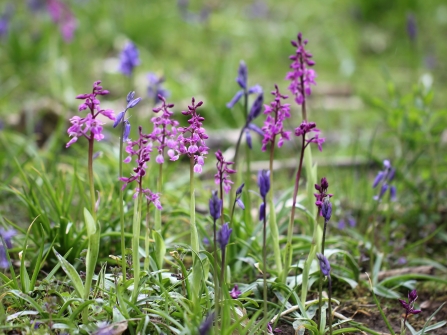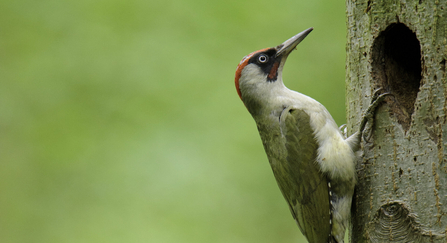
Early purple orchids with bluebells by Jim Higham
A cockchafer beetle about to take flight. Picture: Nick Upton/2020Vision

Early purple orchids with bluebells by Jim Higham
Did you know the UK has more than 50 native species of orchid? And, from the delicate white-and-purple common spotted to the beautiful bee orchid, we have some of the finest examples at our nature reserves. Our Warburg reserve near Henley is the richest BBOWT site for orchids, boasting fly orchid and bird's-nest, and one of our team spotted the first orchids of the year - a pair of early purples - in the woods at Warburg just last week.

Cockchafer beetle by Nick Upton/2020Vision
Cockchafers are one the UK's largest beetles, growing up to 3cm long with shiny chestnut wing cases, and the males sport delicate 'feathered' antennae. Having spent the winter underground as grubs, adults start to emerge in May and June and fly through the air, which can be slightly alarming if you're not expecting it! Listen out for them bumping into illuminated windows on warm evenings across our area.

A female smooth newt laying an egg. Picture: Mark Bradfield
While frogs and toads have mostly finished mating by now, and ponds are starting to blossom with black clouds of their tadpoles, newts will continue breeding into May. Our Kintbury Newt Ponds in West Berkshire is a fantastic place to spot newts, boasting all three British species. Female newts lay their eggs at night, by folding submerged leaves in half to make little pockets. See if you can spot these curious half-leaves in ponds this month.


A chicken of the woods fungus (Laetiporus sulphureus) growing on the trunk of a tree. Picture: Vaughn Matthews
Most mushrooms fruit in autumn and spring, but the wonderfully-named chicken of the woods is one of our summer species, and also one of our most spectacular: its bright orange brackets burst out from the trunks of beech, oak and chestnut trees. Look out for it in woodlands with dappled sunlight like our Foxholes reserve between Chipping Norton and Burford.

Common lizard by Andy Fairbairn
Have you ever seen a lizard in the UK? We have a lot of them! Common lizards can be found on many of our reserves including Snelsmore Common near Newbury and Sydlings Copse near Oxford. Look out for them on sunny days, basking in the sunshine to warm up before they go hunting for worms and other invertebrates.

A group of rabbits outside the entrance to a warren. Picture: Bob Coyle
Did you know that rabbits are not native to the British Isles? It is believed the Normans introduced them for food - but their sheer reproductive rate meant they quickly became an established species - and this is the time of year when they do their reproducing! Look out for adult males in grasslands like Greenham Common, spraying urine to mark their territoriy - and spraying females to begin courtship!

Mallard with ducklings by Andrew Parkinson/2020VISION
All birds have chicks, and the lake at BBOWT's Nature Discovery Centre in Thatcham is one of the best places to see waterfowl in our three counties. As well as fluffy ducklings, goslings and signets, look out for great crested greblings riding on their mother's back, and a host of other chicks appearing over the coming weeks.

Fox cubs. Picture: Jon Hawkins/ Surrey Hills Photography
As May starts, most fox parents will still be foraging to feed their growing cubs, but now the youngsters might start to accompany the adults on hunting expeditions, looking for small mammals such as mice, voles, weasels and rabbits. Although a lot of hunting happens at night, cubs can occasionally be spotted starting to explore their neighbourhoods in the daylight as well - so long as they don't suspect there are any humans about!

Green woodpecker by Andrew Mason
The UK has three species of woodpecker, but the largest is the green. It nests in holes that it excavates in trees in broadleaved woodlands, orchards, large parks and gardens. It can often be seen hopping about on pastures and lawns, looking for ants and invertebrates to eat. We are lucky to have these beautiful birds at many of our reserves, including Iffley Meadows in Oxford, Finemere Wood near Bicester and Dancersend near Aylesbury. Listen out for their laughing 'yaffle' call.
Blog: What is the difference between the UK's three woodpeckers?

One of the dramatic natural spectacles of this time of year is honey bees swarming - and although their sudden appearance in a garden or a supermarket carpark can cause alarm, they are unlikely to pose any threat to humans and leave of their own accord. But did you know that, as well as honeybees, the UK has more than 200 species of solitary bee? From the hairy-footed flower bee to the box-headed blood bee, these attractive insects come in a huge variety of shapes and sizes, and are now thought by many scientists to be more valuable to humans for their pollination services than all our honeybees put together.
Sign up below to receive the latest news from BBOWT, tips about how you can help wildlife, plus information on how you can get involved.